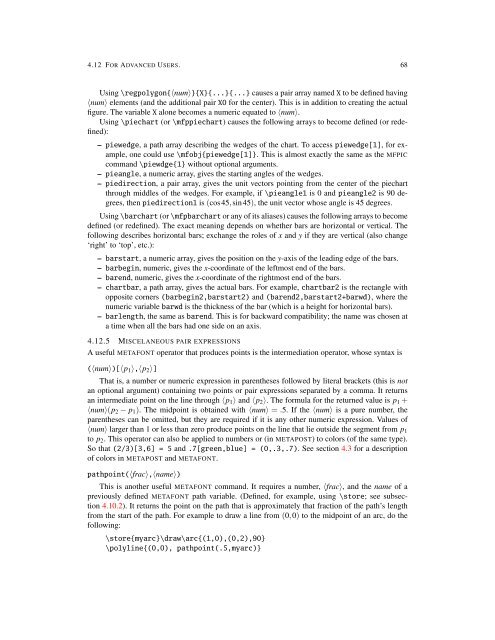You also want an ePaper? Increase the reach of your titles
YUMPU automatically turns print PDFs into web optimized ePapers that Google loves.
4.12 FOR ADVANCED USERS. 68<br />
Using \regpolygon{〈num〉}{X}{...}{...} causes a pair array named X to be defined having<br />
〈num〉 elements (and the additional pair X0 for the center). This is in addition to creating the actual<br />
figure. The variable X alone becomes a numeric equated to 〈num〉.<br />
Using \piechart (or \mfppiechart) causes the following arrays to become defined (or redefined):<br />
– piewedge, a path array describing the wedges of the chart. To access piewedge[1], for example,<br />
one could use \mfobj{piewedge[1]}. This is almost exactly the same as the MFPIC<br />
command \piewdge{1} without optional arguments.<br />
– pieangle, a numeric array, gives the starting angles of the wedges.<br />
– piedirection, a pair array, gives the unit vectors pointing from the center of the piechart<br />
through middles of the wedges. For example, if \pieangle1 is 0 and pieangle2 is 90 degrees,<br />
then piedirection1 is (cos45,sin45), the unit vector whose angle is 45 degrees.<br />
Using \barchart (or \mfpbarchart or any of its aliases) causes the following arrays to become<br />
defined (or redefined). The exact meaning depends on whether bars are horizontal or vertical. The<br />
following describes horizontal bars; exchange the roles of x and y if they are vertical (also change<br />
‘right’ to ‘top’, etc.):<br />
– barstart, a numeric array, gives the position on the y-axis of the leading edge of the bars.<br />
– barbegin, numeric, gives the x-coordinate of the leftmost end of the bars.<br />
– barend, numeric, gives the x-coordinate of the rightmost end of the bars.<br />
– chartbar, a path array, gives the actual bars. For example, chartbar2 is the rectangle with<br />
opposite corners (barbegin2,barstart2) and (barend2,barstart2+barwd), where the<br />
numeric variable barwd is the thickness of the bar (which is a height for horizontal bars).<br />
– barlength, the same as barend. This is for backward compatibility; the name was chosen at<br />
a time when all the bars had one side on an axis.<br />
4.12.5 MISCELANEOUS PAIR EXPRESSIONS<br />
A useful METAFONT operator that produces points is the intermediation operator, whose syntax is<br />
(〈num〉)[〈p 1 〉,〈p 2 〉]<br />
That is, a number or numeric expression in parentheses followed by literal brackets (this is not<br />
an optional argument) containing two points or pair expressions separated by a comma. It returns<br />
an intermediate point on the line through 〈p 1 〉 and 〈p 2 〉. The formula for the returned value is p 1 +<br />
〈num〉(p 2 − p 1 ). The midpoint is obtained with 〈num〉 = .5. If the 〈num〉 is a pure number, the<br />
parentheses can be omitted, but they are required if it is any other numeric expression. Values of<br />
〈num〉 larger than 1 or less than zero produce points on the line that lie outside the segment from p 1<br />
to p 2 . This operator can also be applied to numbers or (in METAPOST) to colors (of the same type).<br />
So that (2/3)[3,6] = 5 and .7[green,blue] = (0,.3,.7). See section 4.3 for a description<br />
of colors in METAPOST and METAFONT.<br />
pathpoint(〈frac〉,〈name〉)<br />
This is another useful METAFONT command. It requires a number, 〈frac〉, and the name of a<br />
previously defined METAFONT path variable. (Defined, for example, using \store; see subsection<br />
4.10.2). It returns the point on the path that is approximately that fraction of the path’s length<br />
from the start of the path. For example to draw a line from (0,0) to the midpoint of an arc, do the<br />
following:<br />
\store{myarc}\draw\arc{(1,0),(0,2),90}<br />
\polyline{(0,0), pathpoint(.5,myarc)}

















